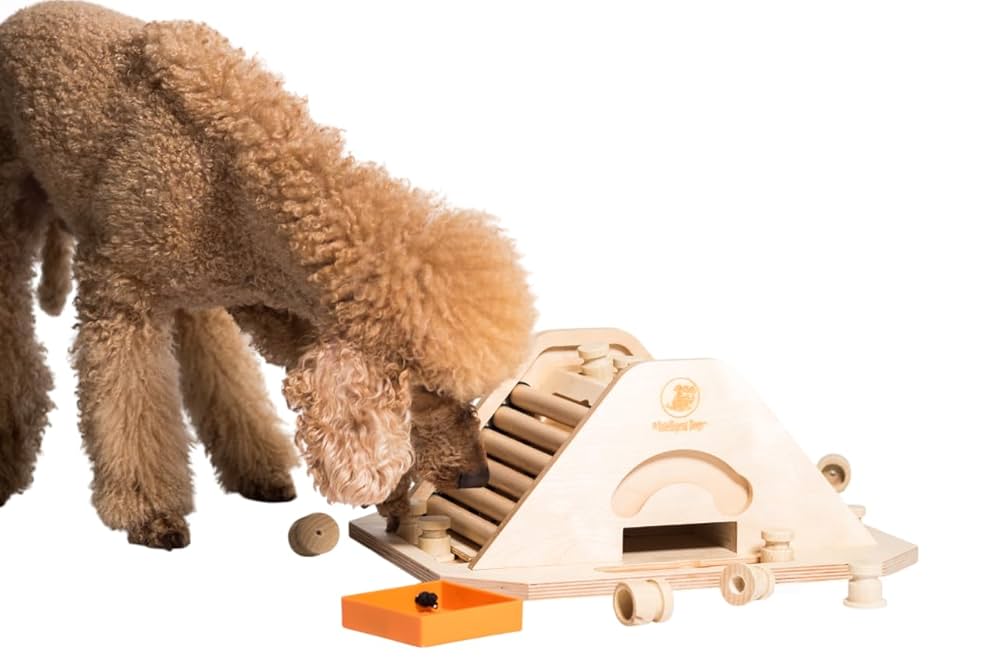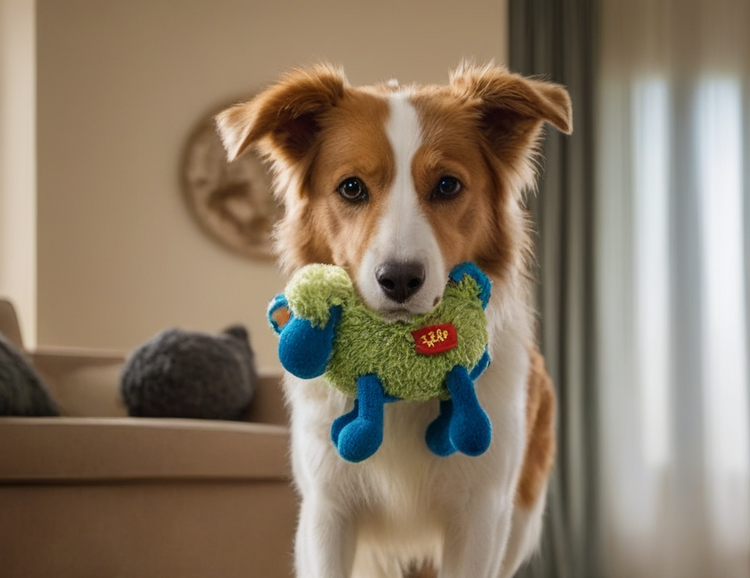New
Smart and Interactive Toys: Stimulating Your Pet’s Body and Mind
1. The Evolution of Pet Play: From Simple Objects to Smart Companions
The bond between humans and companion animals has always involved play. For centuries, guardians have offered their pets simple objects—a stick, a rope, a feather—to satisfy natural instincts and to build emotional closeness. Yet as our understanding of animal psychology, neuroscience, and behavior deepens, so too has the concept of play evolved. Today, smart and interactive toys have emerged as a revolutionary category that reshapes how pets experience daily life, exercise, and learning.

From Traditional Toys to Intelligent Systems
Traditional toys such as chew bones, stuffed animals, or squeaky balls are still staples in households around the world. They provide entertainment and an outlet for instinctive drives like chewing, pouncing, or chasing. However, these objects lack adaptability. Once the novelty wears off, pets often lose interest, leading to boredom and under-stimulation.
Interactive and smart toys solve this problem by introducing unpredictability, learning opportunities, and real-time responses. Instead of a ball that simply rolls, we now have robotic balls that can alter direction, pause strategically, and even respond to a dog’s bark or a cat’s paw swipe. Puzzle feeders dispense food only when a task is completed, keeping pets mentally engaged while satisfying hunger.
The result is more than just entertainment—it is an enrichment system. By challenging the body and the brain simultaneously, these toys mimic the complexity of hunting, problem-solving, and social interaction that animals would normally encounter in the wild.
Technological Drivers Behind Smart Pet Toys
Several breakthroughs have made the modern era of pet toys possible:
-
Sensors and Motion Detection: Toys can now “sense” when a pet is near and activate automatically, creating a responsive play experience.
-
Artificial Intelligence: Machine learning algorithms allow some toys to adapt difficulty levels or alter movement patterns to keep animals engaged over time.
-
App Integration: Guardians can control toys via smartphones, schedule play sessions, or even monitor their pets through built-in cameras.
-
Sustainability Trends: Eco-conscious materials ensure safety for animals and reduce environmental impact.
These technologies address the dual challenge many modern guardians face: pets need stimulation even when owners are absent, and owners want reassurance that their pets remain happy and healthy during long work hours.
Scientific Evidence for Cognitive and Physical Benefits

Studies in veterinary behavioral science confirm that structured interactive play enhances neuroplasticity—the brain’s ability to form new neural connections. Dogs exposed to problem-solving toys demonstrate faster adaptability, improved impulse control, and stronger memory retention. Cats given varied play opportunities early in life develop better spatial awareness and sharper reflexes than those deprived of stimulation.
Furthermore, engaging toys help prevent behavioral problems rooted in boredom or frustration, such as excessive barking, destructive chewing, or inappropriate scratching. In many cases, a $30 smart puzzle feeder can save guardians hundreds of dollars in damage repair or training interventions.
2. Categories of Smart and Interactive Toys
Not all toys serve the same purpose. To maximize enrichment, guardians should understand the diverse categories available and how each type supports physical, emotional, and cognitive needs.
2.1 Puzzle Feeders and Treat Dispensers
Puzzle feeders are perhaps the most widespread type of interactive toy. These devices require pets to manipulate levers, spin wheels, or push compartments to access food. The process stimulates problem-solving skills, slows down eating (reducing risks of obesity or bloating), and keeps pets occupied for extended periods.
For example, a dog accustomed to inhaling meals within 60 seconds may take 10 minutes to finish when using a puzzle feeder, turning mealtime into both a challenge and a workout. Cats, natural hunters that thrive on stalking behavior, find treat balls or maze feeders especially rewarding.
2.2 Motion-Based Smart Toys
Robotic mice, rolling balls, and motion-activated teasers simulate prey-like behavior. These toys are invaluable for cats, whose instinctive hunting patterns rely on stalking and sudden bursts of speed. Unlike static toys that quickly lose appeal, motion-based devices keep animals guessing.
For dogs, automatic ball launchers extend play beyond human presence. High-energy breeds such as Border Collies or Retrievers benefit immensely, burning off excess energy and reducing anxiety-related behaviors.
2.3 Sensory Enrichment Devices
Some toys integrate lights, sounds, or textures that respond dynamically to touch. For instance, a ball that lights up when pawed or a squeaky toy that changes pitch depending on pressure creates layers of sensory engagement. These devices are particularly effective for puppies and kittens in developmental stages when sensory input strengthens neural pathways.
2.4 Connected and Remote-Controlled Toys

One of the fastest-growing markets involves toys controlled via smartphone apps. Guardians at work can remotely activate a laser toy for their cat, launch a ball for their dog, or even speak to them through built-in microphones. Some devices include video cameras, enabling two-way interaction. This level of engagement reduces loneliness and strengthens bonds despite physical separation.
2.5 Training-Oriented Smart Tools
Training-oriented toys use positive reinforcement. For example, a dispenser releases a treat when a dog presses a button, sits calmly, or completes a trick. Such tools combine play with obedience training, making the learning process enjoyable rather than stressful.
3. The Broader Implications of Smart Play for Pet Welfare
The impact of smart and interactive toys goes beyond individual households. It reflects broader cultural, economic, and ethical shifts in how society views companion animals.
3.1 Mental Health and Emotional Stability
Just as humans experience stress, anxiety, and depression, pets too suffer from mental health challenges. Lack of stimulation is one of the leading causes of behavioral disorders. Smart toys offer an antidote by channeling nervous energy into constructive activity, providing a sense of purpose, and reducing destructive tendencies.
Shelters worldwide have incorporated enrichment programs featuring interactive toys. Results show higher adoption rates, as animals that appear playful and mentally balanced attract more potential guardians.
3.2 Human-Animal Bond Reinforcement
Play is a language of trust and affection. A dog that eagerly returns a robotic ball or a cat that pounces on an app-controlled laser is not only exercising but also communicating joy and connection. When guardians actively participate—either physically or remotely—they deepen emotional ties.
Families with children particularly benefit, as kids learn empathy, responsibility, and patience through shared play sessions. Toys become educational tools that teach children to respect animal needs while enhancing family cohesion.
3.3 Addressing Urban Living Challenges
Urbanization often means limited outdoor space. Dogs confined to apartments or cats living exclusively indoors require substitutes for natural exploration. Interactive toys replicate elements of hunting, chasing, and problem-solving, ensuring pets thrive despite environmental constraints.
For example, an indoor-only cat may never catch a real mouse, but a robotic toy mimicking erratic prey movements satisfies its innate drive. Similarly, a city dog lacking open fields can still enjoy structured play with automated fetch devices.
3.4 Economic and Industry Growth
The global pet toy market is a multibillion-dollar industry, and smart toys represent its fastest-growing sector. The demand fuels innovation, job creation, and cross-industry collaborations between tech companies, veterinarians, and pet product designers.
Customization through 3D printing allows guardians to order toys tailored to breed, size, or even cognitive skill level. Sustainability trends push manufacturers toward biodegradable plastics, recycled fabrics, and eco-friendly packaging.
3.5 Ethical Considerations
While technology enriches lives, it also raises ethical questions. Should toys replace human interaction? Experts emphasize balance: interactive devices are supplements, not substitutes. Guardians must ensure toys do not become an excuse for neglecting personal engagement. Furthermore, safety standards are paramount—small parts, toxic materials, or poorly designed mechanisms can pose hazards.
Play as a Lifelong Commitment
Smart and interactive toys are not passing fads; they represent a paradigm shift in companion animal care. They blend science, technology, and compassion into tools that stimulate both body and mind, ensuring pets live enriched, balanced, and joyful lives.
By choosing toys wisely, rotating them for novelty, and supervising play responsibly, guardians invest not merely in entertainment but in the mental health, physical vitality, and emotional security of their beloved companions.
Ultimately, the principle remains timeless: play is love in action. Technology simply offers us new, creative ways to express that love.
4. Expanding Horizons: Global Perspectives on Enrichment
Cultural Approaches to Play
Different societies nurture pets in unique ways, and the evolution of smart toys reflects cultural values. In Japan, compact living spaces have fueled innovation in robotic companions that keep cats entertained without requiring sprawling environments. In Scandinavia, where outdoor activity is integral, interactive fetch devices designed to withstand harsh weather dominate the market. Meanwhile, in North America, app-based solutions mirror the high adoption of smartphones, allowing owners to schedule play during long office hours.
Impact of Urbanization and Lifestyle Shifts
As cities expand and daily routines become busier, guardians face less time to engage physically with their companions. Smart enrichment tools bridge that gap by offering structured stimulation that fits modern schedules. Automated feeders combined with puzzle modules ensure nutrition is paired with mental challenges, reducing stress for both animal and human.
Adoption in Developing Regions
Interestingly, even in emerging economies, the popularity of interactive toys is rising. Local artisans craft budget-friendly puzzle feeders from recycled materials, proving that innovation does not always require advanced electronics. These grassroots initiatives highlight the universal recognition that play is vital for wellbeing, regardless of geography or income level.
6. Practical Integration: Making Interactive Play Part of Daily Life
Creating a Balanced Routine
Introducing smart devices requires strategy. Guardians should blend traditional exercise with technologically enhanced play to achieve harmony. For example, a morning walk followed by a session with a robotic ball satisfies both physical and mental demands. Evening routines might involve slower-paced activities such as a treat maze or interactive licking mat that promotes calmness before bedtime.
Toy Rotation Strategies
Animals, much like humans, experience novelty fatigue. A once-exciting robotic mouse can become mundane after weeks of exposure. Effective guardians implement rotation systems: dividing toys into groups and reintroducing them cyclically. This method keeps enrichment fresh without continuous spending and allows observation of individual preferences.
Age-Specific Considerations
-
Puppies and Kittens: Require sensory-rich, safe objects that foster coordination without overwhelming delicate bodies.
-
Adolescents: Benefit from problem-solving challenges that channel energy constructively, preventing destructive habits.
-
Adults: Thrive with advanced puzzles, interactive fetch games, and training-focused devices that sustain cognitive sharpness.
-
Seniors: Need gentle stimulation, such as slower-moving robots or light-based toys that accommodate reduced mobility yet keep minds active.
Household Dynamics
Multi-pet families face unique challenges. Introducing interactive objects should account for competition, guarding behavior, and individual temperaments. Providing duplicates or designing shared play opportunities minimizes conflict. Some guardians find success with cooperative puzzle boards where animals work simultaneously to access rewards, fostering teamwork rather than rivalry.
7. Innovation and the Future of Pet Play
Artificial Intelligence Integration
The next generation of enrichment tools incorporates adaptive intelligence. These systems learn from a pet’s behavior, adjusting difficulty levels or modifying movement patterns in real time. A dog that masters a puzzle quickly will find the next session slightly harder, ensuring ongoing growth. Similarly, a cat showing frustration may trigger the toy to simplify interactions, preventing discouragement.
Wearable-Linked Toys
Collars and harnesses embedded with sensors transmit data on heart rate, steps taken, and activity levels. Toys connected to these devices adjust play intensity accordingly. If a dog has been sedentary all morning, the toy may initiate high-energy chases. If the same dog already engaged in vigorous activity, the toy may provide calmer, cognitive challenges.
Augmented and Virtual Play Worlds
Cutting-edge research explores the potential of projecting interactive light patterns, holograms, or augmented shapes that animals can chase safely indoors. While experimental, these innovations promise stimulation that transcends physical limitations, offering boundless possibilities in compact urban homes.
Sustainable Manufacturing and Eco-Friendly Design
The environmental footprint of pet products cannot be ignored. Responsible manufacturers increasingly use biodegradable plastics, organic fabrics, and recyclable packaging. Some even design modular toys with replaceable components, reducing waste and extending lifespan. Guardians choosing sustainable enrichment support both planetary health and animal welfare.
Cross-Species Expansion
While much focus lies on dogs and cats, smart enrichment benefits extend to rabbits, ferrets, parrots, and even reptiles. Specialized devices are being designed: chew-proof puzzles for rodents, interactive perches for birds, and heat-responsive platforms for reptiles. Recognizing the diversity of companion animals expands opportunities for inclusive innovation.
A Vision for Holistic Pet Futures
The trajectory of smart and interactive toys mirrors humanity’s growing respect for animal minds. No longer perceived as mere accessories, pets are recognized as sentient beings deserving of stimulation, challenge, and joy.
These innovations do more than entertain. They combat loneliness, prevent behavioral decline, and foster deeper interspecies understanding. They reflect a society that sees companionship as reciprocal, where guardians invest in both physical vitality and cognitive flourishing of their animals.
The horizon is bright: artificial intelligence adapting to emotional states, virtual environments offering endless exploration, and sustainable practices ensuring enrichment aligns with ecological responsibility. What remains constant is the timeless truth—play is essential, not optional. Through smart and interactive tools, that truth finds modern expression, shaping futures where pets live not only longer but also richer, more fulfilling lives.
8. Beyond Entertainment: The Deeper Purposes of Interactive Play
Emotional Regulation Through Engagement
While toys are often marketed as “fun accessories,” their true potential lies in emotional management. Intelligent devices can reduce loneliness, mitigate separation stress, and provide comfort during transitional events such as moving homes or welcoming new family members. Studies in animal psychology suggest that consistent play helps regulate mood swings and enhances resilience against anxiety disorders.
Preventing Behavioral Deterioration
Destructive chewing, excessive barking, and compulsive grooming are frequently signs of under-stimulation. Introducing sophisticated gadgets that demand attention and effort diverts energy away from negative habits. For example, chew-proof puzzle cubes occupy strong-jawed breeds, while laser robots deter cats from scratching furniture by offering a rewarding hunting substitute.
Building Autonomy and Confidence
Not all enrichment requires human intervention. Devices designed to respond independently to pet actions allow animals to explore problem-solving at their own pace. This autonomy fosters confidence, particularly for timid personalities that may shy away from constant human guidance. By “winning” a challenge on their own, pets develop independence alongside joy.
9. Integration With Broader Health and Lifestyle Goals
Fitness and Weight Management
Veterinarians emphasize that obesity is one of the most prevalent modern pet health issues. Smart feeders integrated with timed release mechanisms can prevent overeating while doubling as exercise tools. Dogs might chase treat-dispensing balls across the living room, burning calories while eating. Cats can leap and stretch to retrieve morsels, combining diet control with physical training.
Cognitive Longevity in Aging Animals
Senior pets often face cognitive decline similar to dementia in humans. Mental stimulation from interactive toys slows deterioration by challenging memory, focus, and coordination. A gentle puzzle board with large levers may help an older dog maintain clarity, while scent-based mazes can reawaken fading instincts in elderly cats.
Rehabilitation and Special Needs Care
Post-surgery recovery or mobility challenges require specialized enrichment. Adaptive toys using gentle vibrations, slow-moving lights, or soft sounds engage senses without overtaxing fragile bodies. For blind or visually impaired pets, toys emphasizing texture and scent deliver valuable stimulation otherwise lost.
Harmony With Human Wellness
Interestingly, pet enrichment correlates with human wellbeing. Guardians who engage alongside interactive devices often experience reduced stress, improved cardiovascular health, and greater emotional satisfaction. The act of co-play strengthens bonds and creates daily rituals that benefit both species.
10. Looking Ahead: The Future of Interactive Innovation
Multi-Sensory Stimulation
The next wave of toy development emphasizes full-spectrum experiences: combining sound, motion, vibration, and even aroma to replicate hunting or herding scenarios. Imagine a ball that not only bounces unpredictably but emits faint prey-like sounds and scent markers—immersing pets in a realistic adventure without leaving home.
AI-Powered Personal Trainers
Adaptive systems are advancing toward becoming digital “trainers.” These programs monitor engagement patterns, detect fatigue, and recommend play adjustments. A toy might encourage sprints for a high-energy breed or switch to mental puzzles for a calmer personality, offering bespoke experiences in real time.
Community and Social Connectivity
Future designs may allow animals in separate households to “play together” virtually. Two dogs in different cities could chase synchronized robotic balls linked via cloud software, fostering companionship beyond physical distance. Cats might interact with remote feather bots controlled by friends or family abroad, reinforcing social ties across borders.
Ethical Considerations and Responsible Use
As sophistication grows, so does responsibility. Guardians must guard against over-reliance, ensuring machines complement—not replace—human affection. Ethical debates also surround data collection by app-connected devices. Safeguarding privacy while promoting wellness will be a central theme as the market expands.
Expanding Inclusivity
Until now, most smart enrichment targets cats and dogs. The future promises tailored designs for reptiles, guinea pigs, horses, or even aquarium species. Each innovation broadens horizons, reinforcing the principle that every creature deserves stimulation aligned with its natural instincts.
Enrichment as a Cornerstone of Modern Pet Care
Smart and interactive toys are no longer luxuries; they are integral to holistic guardianship. They address emotional stability, prevent destructive habits, complement nutrition, and extend vitality well into senior years.
The trajectory points toward a world where pets thrive in enriched environments that respect their individuality. With advancements in artificial intelligence, sustainable design, and cross-species adaptation, the possibilities are boundless. Guardians embracing these tools do more than entertain—they empower their companions to live balanced, fulfilling lives in harmony with the digital age.
Expanding the Horizons of Pet Enrichment
Interactive gadgets are redefining what companionship looks like in households worldwide. While their most obvious benefit is keeping animals occupied, the ripple effects reach far beyond simple play. By weaving together movement, curiosity, and sensory triggers, these inventions create daily rituals that transform idle moments into meaningful experiences.
Encouraging Natural Curiosity
Domestic environments often limit an animal’s instinctual outlets. A shepherd without sheep or a feline without hunting grounds can become restless or disengaged. Modern enrichment compensates for these lost opportunities by simulating natural behaviors in a safe, controlled way. Toys that hide food, mimic prey, or respond unpredictably encourage exploration and awaken curiosity, reducing frustration in confined settings.
Strengthening Human-Pet Communication
Another overlooked dimension of interactive design is its role in communication. Many devices require guardians to initiate or guide sessions, reinforcing cooperative dynamics. Through these interactions, animals learn to interpret signals, gestures, or cues, building mutual understanding. A light-up puzzle, for instance, might become a shared language where the human prompts and the pet responds, deepening trust.
Bridging Technology and Compassion
Emerging innovations demonstrate that progress does not need to compromise empathy. Solar-powered mechanisms, biodegradable materials, and low-noise engineering show a commitment to sustainability and comfort. Thoughtful construction ensures enrichment tools are not only stimulating but also safe, eco-friendly, and considerate of household harmony.
Global Accessibility and Affordability
For enrichment to truly make a difference, it must be accessible. Start-ups and community-driven projects are experimenting with open-source blueprints, allowing guardians to create DIY versions at home. From cardboard mazes to smartphone-controlled lasers, affordability ensures that stimulation is not a privilege but a standard of responsible care.
Looking Toward Holistic Wellbeing
The greatest promise of smart play lies in its ability to integrate with a larger wellness strategy. Nutrition, training, socialization, and medical care are all reinforced by consistent stimulation. When toys are used not merely as distractions but as part of a comprehensive plan, they elevate overall quality of life. Pets experience fewer behavioral issues, maintain healthier bodies, and demonstrate more balanced temperaments.

